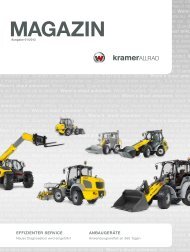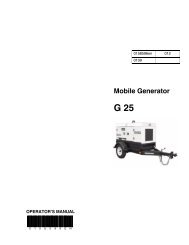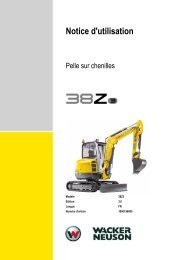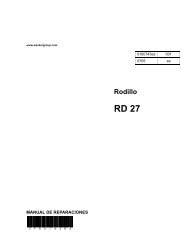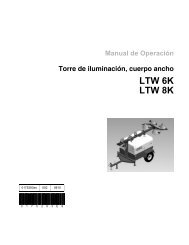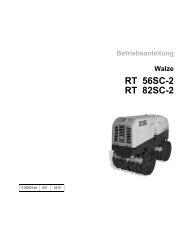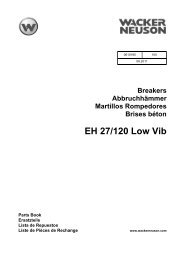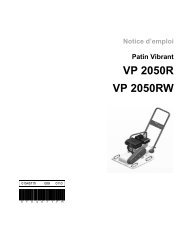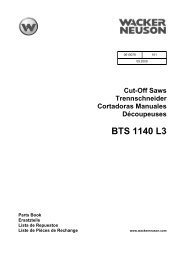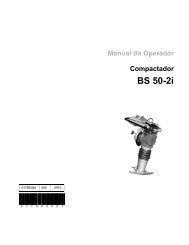Repair Manual Mobile Generator - Wacker Neuson
Repair Manual Mobile Generator - Wacker Neuson
Repair Manual Mobile Generator - Wacker Neuson
You also want an ePaper? Increase the reach of your titles
YUMPU automatically turns print PDFs into web optimized ePapers that Google loves.
<strong>Mobile</strong> <strong>Generator</strong> Theory of Operation<br />
2.2 Introduction<br />
See Graphic: wc_gr003303<br />
A generator set is a transducer, which means it converts energy from<br />
one form (heat) into another (electrical). The two main components of<br />
a generator set are the prime mover (engine) and the generator<br />
assembly. The engine converts heat into rotating mechanical energy<br />
which is then converted by the generator assembly into electrical<br />
energy. The generator does so through the principle of<br />
electromagnetic induction. This principle states that when a coil of wire<br />
(also known as a winding) is passed through a magnetic field, a<br />
voltage is induced in the winding. The amount of voltage depends on<br />
three factors: 1) the speed of the coil cutting through the magnetic field<br />
(it does not matter which is moving—either the magnetic field or the<br />
winding); 2) the strength of the magnetic field; and 3) the amount of<br />
turns of wire in the winding. The principle also works in reverse; that is,<br />
if voltage and current are present in a coil of wire, a magnetic field is<br />
produced. It is important to understand this basic theory to understand<br />
how the generator functions.<br />
The typical brushless generator assembly consists of a stator<br />
(stationary element), a rotor (rotating element), a voltage regulator<br />
(voltage control device), and a rectifier assembly (current control<br />
device). The rotor can function as either the magnetic field or the<br />
winding. Likewise, the stator can function as either the magnetic field<br />
or the winding, depending on the application. In <strong>Wacker</strong> <strong>Neuson</strong><br />
generators there are two stators (a and b) and a single rotor assembly<br />
(c). The rotor assembly is made up of two halves—the exciter (d) and<br />
the main (e). Three windings make up the exciter half and a single<br />
winding makes up the main rotor half. There are three distinct stator<br />
windings—the exciter, the main, and the auxiliary. The exciter stator<br />
winding (a) is a stand-alone winding. The main and auxiliary windings<br />
are housed within the large stator housing (b).<br />
The exciter stator is the generator’s source of residual magnetism. As<br />
the engine spins, the exciter rotor portion of the rotor assembly spins<br />
inside the exciter stator, an AC voltage is induced in the exciter rotor.<br />
This AC voltage is rectified into DC by the diodes (f) connected to the<br />
rotor assembly. The DC voltage flows through the main rotor winding,<br />
creating a magnetic field. Voltage is then induced in the main stator<br />
windings and the auxiliary winding. The voltage induced in the main<br />
stator windings provides the voltage to the lugs and the receptacles.<br />
The voltage induced in the auxiliary winding is used to power the<br />
voltage regulator.<br />
wc_tx001077gb.fm 17



